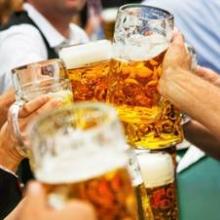Binge drinking appears to be more common in the United States than previously thought, with about 17% of adults aged 18 years and over engaging in the behavior each month.
About 38 million U.S. adults went on at least one drinking binge in 2010, according to a new federal report. Unfortunately, that number probably represents less than a third of the actual binge drinking that goes on, according to Dr. Robert Brewer of the National Center for Chronic Disease Prevention and Health Promotion (NCCDPH).
"We know that surveys like this one pick up only about 33% of presumed alcohol consumption, based on per capita sales," he said in a press briefing. Bingeing accounts for half of the country’s alcohol consumption overall, he noted, and up to 90% of that consumed by young people.
The 2010 Behavioral Risk Factor Surveillance System (BRFSS) found bingeing in virtually every state and in every population group, regardless of age, ethnicity, race, and socioeconomic level. Even states with a comparatively lower prevalence showed serious bingeing problems, Dr. Brewer said. "We found a number of states with a low prevalence but a very high frequency or number of drinks per episode. We can’t be lulled into a false sense of security. There are high-risk drinkers in every population, even though it might not look like a big problem," he said.
The data were compiled through the 2010 BRFSS, an annual nationwide telephone survey. The survey included responses from almost 458,000 civilian U.S. adults in 48 states and the District of Columbia. (South Dakota and Tennessee were not included.) For the first time, cell phone users were included. Binge drinking was defined as four or more drinks for women and five or more drinks for men on one occasion during the past 30 days.
"Physicians need to adopt these numbers – five drinks or more on any occasion for a man and four drinks or more for a woman is unhealthy, unwise, and dangerous," Dr. Robert L. DuPont, the first director of the National Institute on Drug Abuse, said in an interview when asked about the survey. "There is no other step that can match the power of the nation’s physicians once they make this question a routine part of every patient contact."
Overall, bingeing prevalence was up 2% from 2009, but that increase probably is attributable to the inclusion of cell phone users, Dafna Kanny, Ph.D., wrote in the Jan. 10 issue of Morbidity and Mortality Weekly Report (2012;61:1-7).
"Cellular telephone–only users typically are young (aged 18-34 years) and male; both groups tend to report a higher prevalence of binge drinking," wrote Dr. Kanny, also of the NCCDPH.
No group was exempt from the problem, the report found. Men were more likely to binge than women (23.2% vs. 11.4%). Overall, bingeing was most common among those aged 18-34 years (28.2%). But the oldest respondents, those aged 65 years and older, binged the most often, at 5.5 times per month.
Non-Hispanic whites (18%) and Hispanics (17.9%) were significantly more likely to binge than blacks (12.7%).
Education also influenced bingeing. Those who did not graduate from high school had the lowest prevalence (13.7%), but drank more frequently and intensely than those of other educational levels (5.5 times per month with 9.3 drinks per episode).
Respondents with the highest incomes ($75,000 or more) were more likely to binge (20.2%), but those with the lowest incomes ($25,000 or less) drank more frequently and more intensely (5 times per month and 8.5 drinks per episode).
Bingeing also varied by state. Utah had the lowest age-adjusted prevalence (10.9%) and Wisconsin the highest (25.6%) Wisconsin residents also drank the most per episode (9). Bingers drank least often in New Jersey and most often in Kentucky (3.6 vs. 5.9 times per month).
Demographic differences in binge drinking are likely related to laws that affect the price and availability of alcohol, the authors noted. Studies have shows that a 10% price increase can decrease alcohol consumption by 7% in a population.
The Community Preventive Services Task Force has made several recommendations designed to change these factors, including:
• Limiting the density of stores that sell alcohol.
• Holding retailers accountable for harms resulting from sales to minors and already intoxicated persons.
• Maintaining existing limits on times and days of sale.
• Price increases.
• Avoiding further privatization of sales outlets.
"There are high-risk drinkers in every population, even though it might not look like a big problem."


